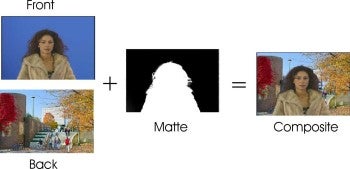Design team members: David Tunnah
Supervisor: Professor Ed Jernigan
Background
Recently, movies and videos have been becoming more and more a part of our lives. When people go to see blockbuster movies these days, they expect to be dazzled by amazing special effects and computer graphics. Often people cannot distinguish between footage that has been digitally altered and footage that has been left untouched.
Almost all effects shots involve footage shot against a blue (or green) screen. The blue screen is an old special effects device that allows directors to create a wide variety of special effects. By combining film clips using a technique called compositing, one replaces all the blue (the blue screen) in a picture with another picture called a background plate. This gives the illusion that the subject originally shot against the blue screen is now in a completely different place or scene, dictated by the background plate. This process is called chroma keying as it produces a final shot called a key.
Currently one can perform chroma keying by using a variety of software (such as that made by Discreet) or hardware (Ultimatte) technologies to key either analog or digital data. The majority of keying in television is done using hardware keyers. These keyers have special hardware that keys the analog video signal fed from the camera. The quality of the resulting composite is good enough for TV but not for film.
Project description
The objective of this project is to design and implement algorithms to automatically generate a key from input film images shot on a blue screen. Algorithms will be designed that automatically find the blue (or green) screen colour and eliminate it from the image. The front image will be analysed and a matte image will be produced. The matte is a grayscale image that describes how to combine the front and back images so as to produce a seamless combination of the two. The final composite should be seamless with no blue edges left over from the blue screen.
Design methodology
The algorithms will work by analysing image features such as the image histogram. The challenge in obtaining a good key is to produce a smooth transition between colours in the background and colours in the foreground. It may be helpful to analyse the image in different colour spaces.
A matte will be produced from the input image by analysing different measures of colour between the background colour and the other colours in the image. The colours must be represented in a way such that only colours that are part of the foreground are carried over into the composite image.
Shown below is a sample of keying technology. The matte shown was created with algorithms designed in this project.
